Last Updated on: 20th December 2024, 12:48 pm
Theth is arguably the most beautiful village in Albania – and possibly in the entire Balkans. While the long hike from Valbonë to Theth is undoubtedly the top hike in the region, hiking to the Blue Eye is well worth staying an extra night in town for.
The mesmerizing turquoise pool of water can be reached in about three hours one-way from southern Theth. And on the walk over, you can also stop to admire the impressive Grunas Waterfall. While mostly flat, the hike also offers bountiful views of Albania’s Accursed Mountains.
The total length of your hike will be greatly affected by the location of your guest house, and you can read more about accommodation at the very end of the article.
About this Hike
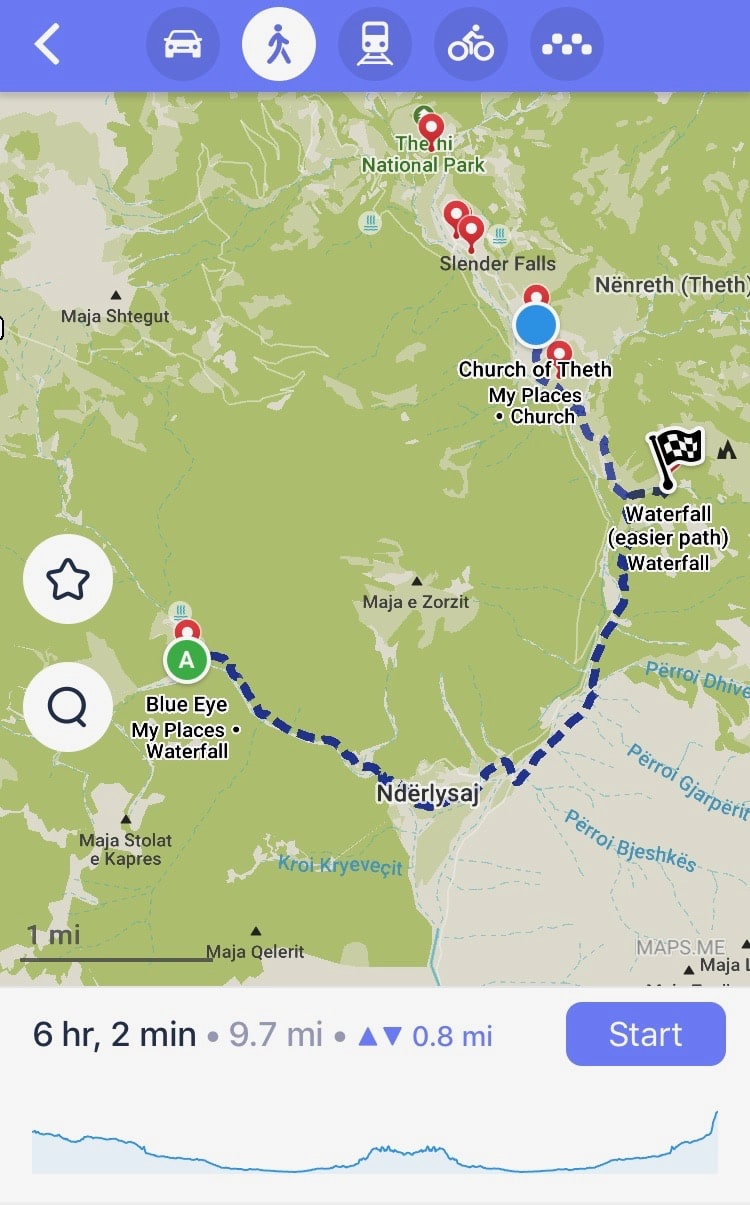
THE BASICS: In terms of elevation, hiking to the Blue Eye and Grunas Waterfall is rather easy. It is, however, quite a long hike, requiring about 6 hours roundtrip – not including the time spent relaxing at each stop.
The starting point is the southern portion of Theth, near the Kulla tower and Theth Church. If your accommodation is further north, then you’ll have to add the walking time to/from the tower to your total journey.
As popular as hiking to the Blue Eye is, there are hardly any trail markers or signage for this hike.
RECOMMENDED APPS: The best app to use for this hike is Maps.me, which contains a very accurate representation of the trail. Additionally, the app even works offline.
Even with help from the app, you’ll still encounter a few tricky parts. But you should be able to figure things out with a bit of trial and error, and you’re unlikely to get very lost.
WHAT TO BRING: There’s not much you need to bring for this hike, other than snacks and water. Over the course of the day, you’ll pass by a couple of cafes, while there’s also a cafe at the Blue Eye itself.
If you have decent hiking boots, then wearing them would be a good idea. But even if you don’t, you’ll be fine in regular tennis shoes, or possibly even sandals.
Hiking to Grunas Waterfall & The Blue Eye
This guide to hiking to the Blue Eye begins at the Kulla tower in southern Theth. The tower, now a museum, originally functioned as a safe haven for local males who got caught up in one of the region’s many blood feuds.
If you haven’t visited yet, you should have time for a quick tour of the tower (200 lek) before setting off for your hike.
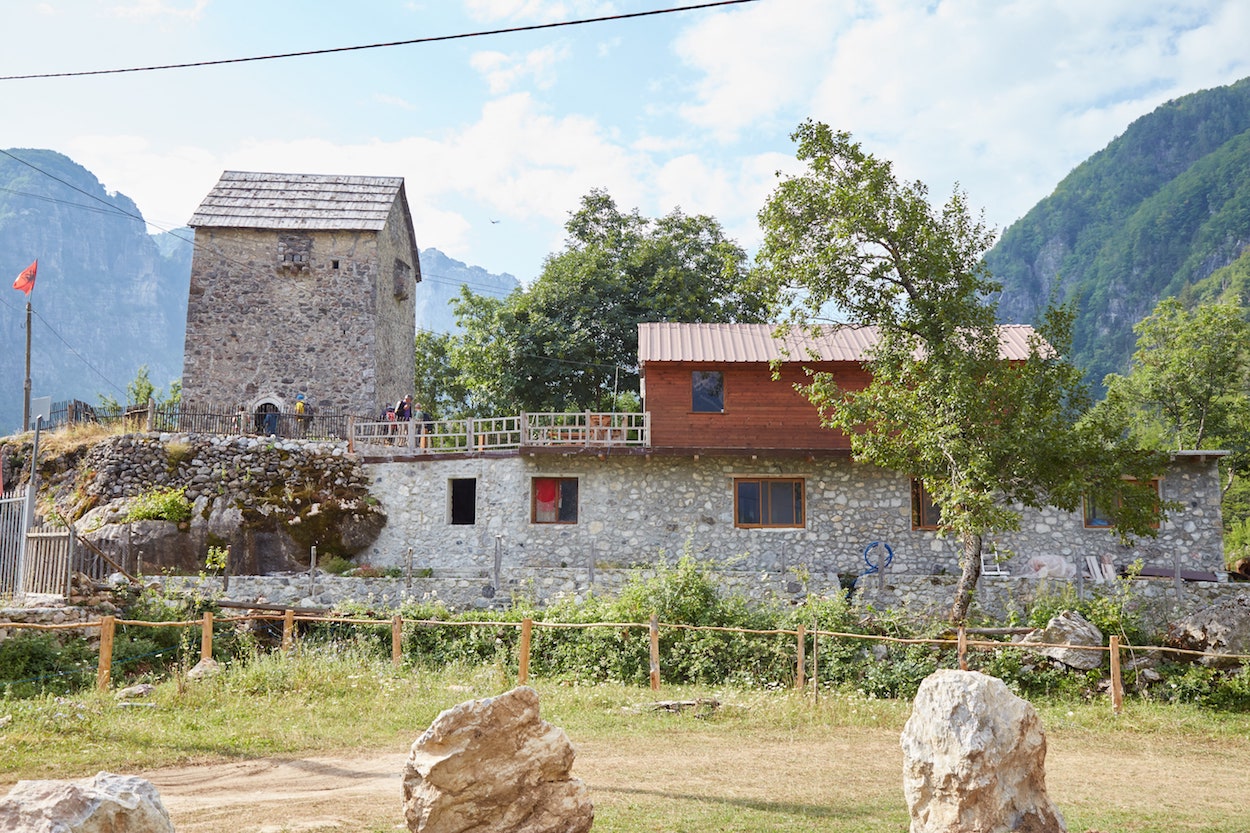
The tower, along with the nearby Church of Theth, are both about 45 minutes on foot from the end of the trail from Valbonë. So even if you’ll be arriving in Theth via the hiking trail from Valbonë, it would be wise to choose accommodation nearby the tower if you plan on later hiking to the Blue Eye.
While this will give you a slightly longer hike from Valbonë, you’ll thank yourself for being able to shorten the Blue Eye hike by up to 90 minutes.

As mentioned above, there are no signs pointing you in the direction of either Grunas Waterfall or the Blue Eye. From the tower, you’ll want to head in the southeast direction. But confusingly, you’ll encounter a few parallel trails.
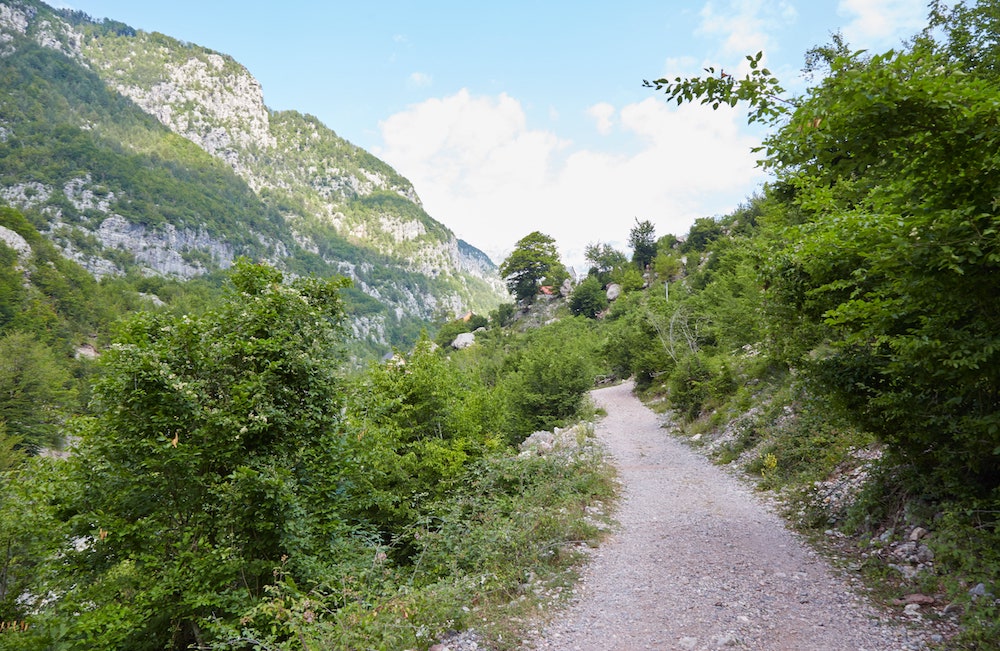
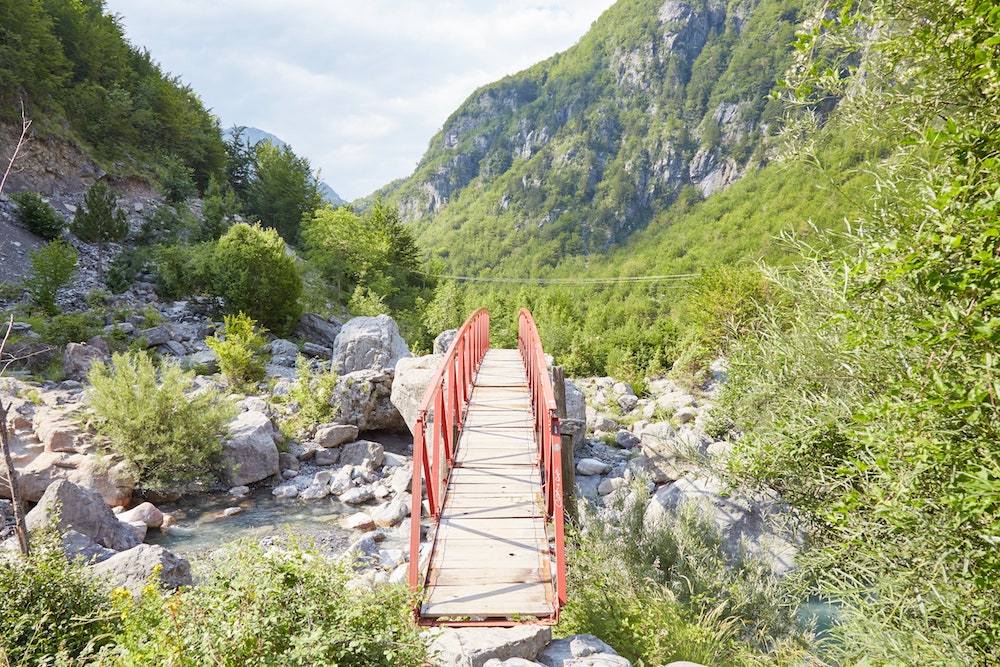
You’ll want to take the southernmost trail. But if you appear lost, a helpful local will likely point you in the right direction.
Passing by some small cottages and a guest house or two on the outskirts of Theth, you’ll soon leave civilization behind. Before long, it will be just you, the trail and the mountains.
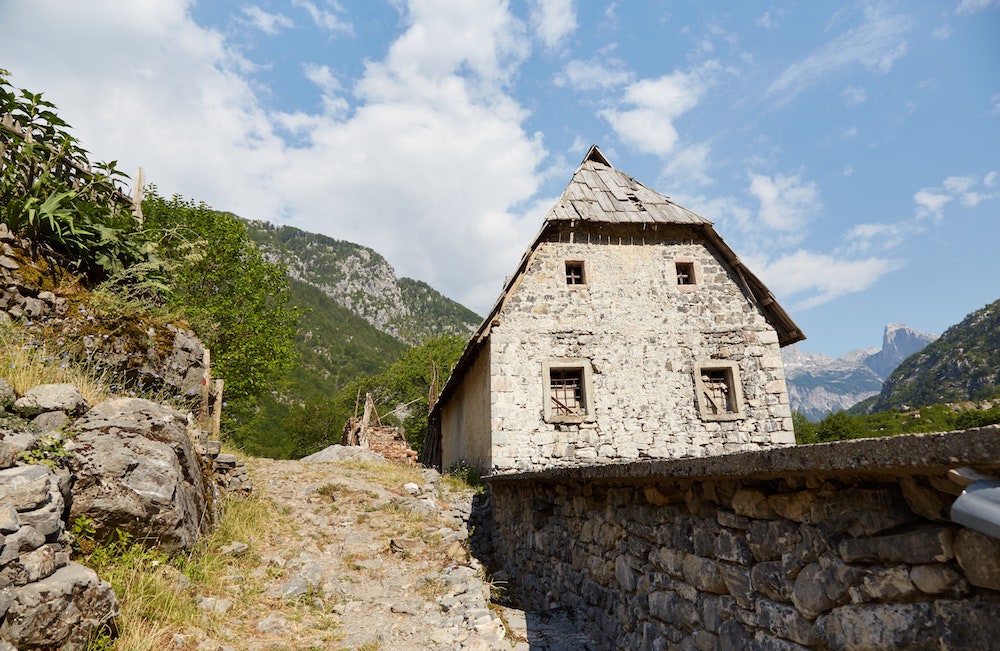
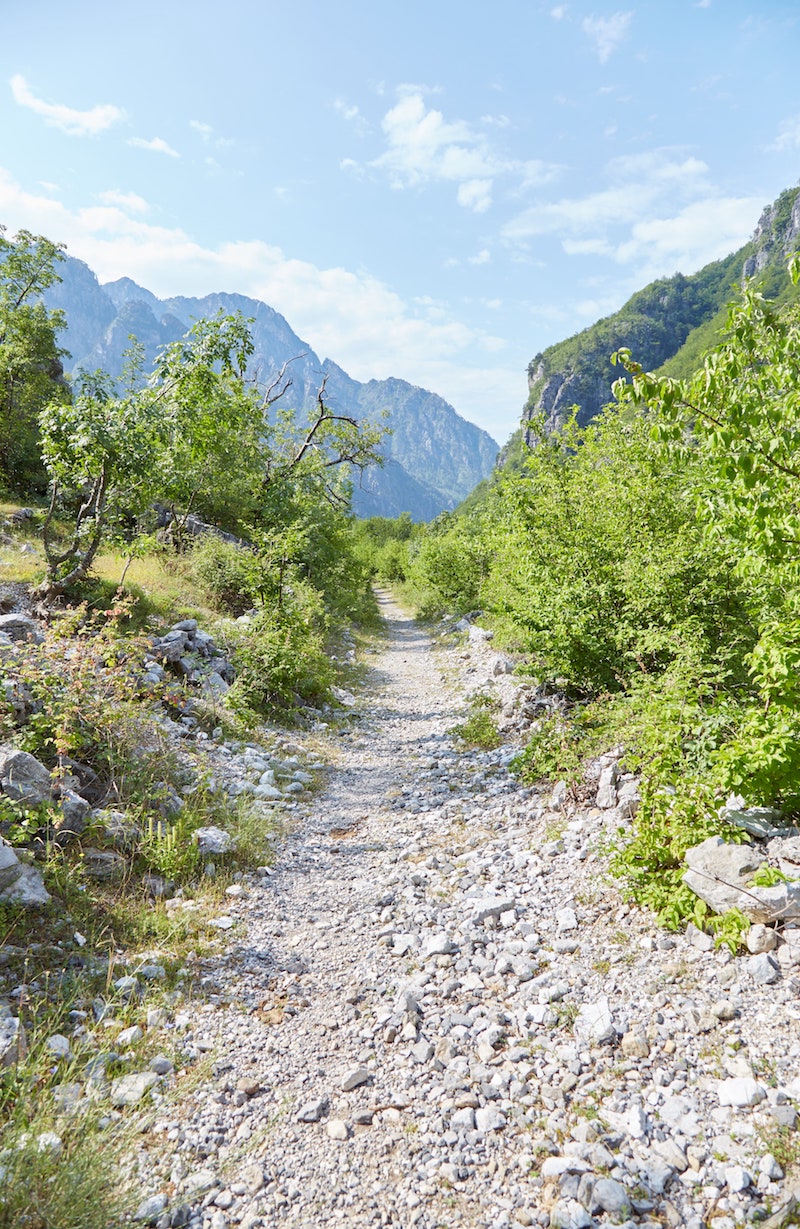
In total, the walk to Grunas Waterfall takes about 45 minutes from the Kulla. But as you’ll notice by looking at the Maps.me trail, there are two alternative paths to get there – a northern one and a southern one.
You’ll have to make your decision fairly soon, as the paths diverge as early as halfway into the walk there. I ended up going with the one to the south.
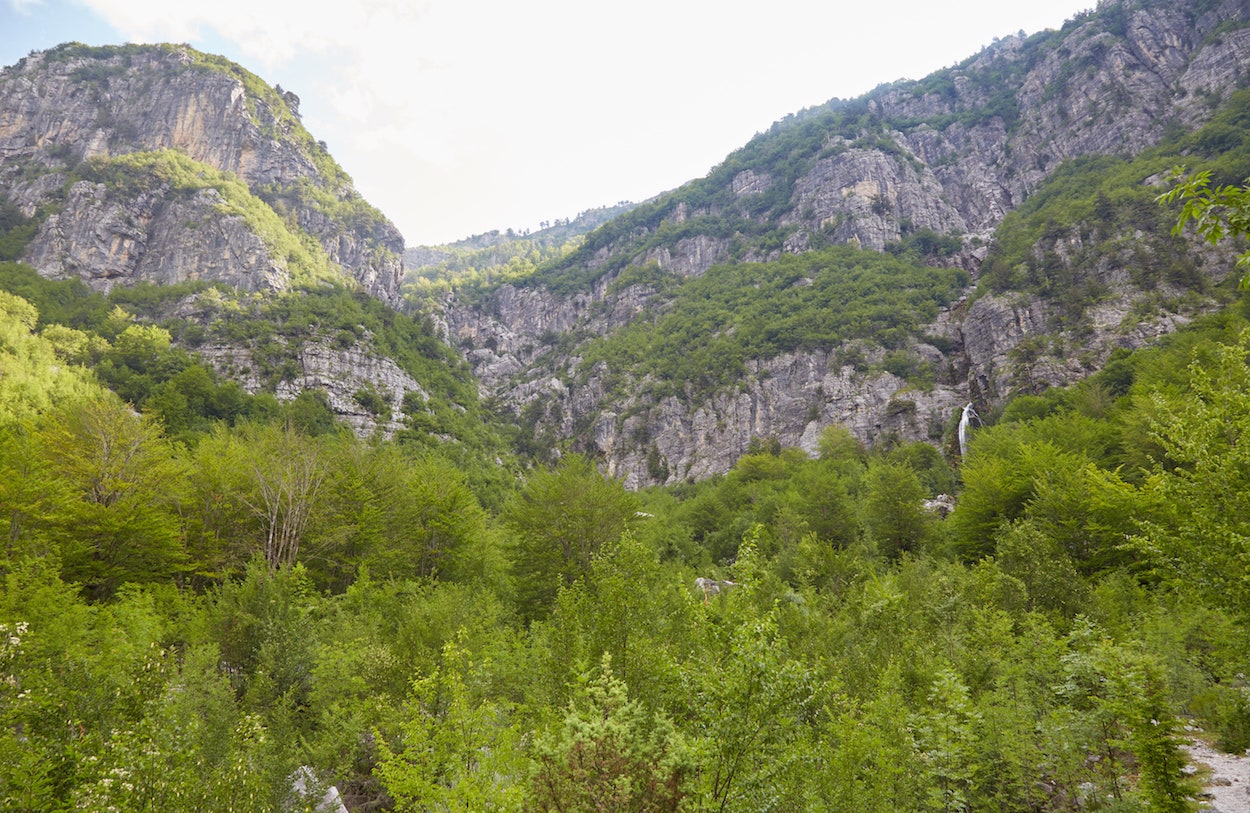
I soon encountered a view of the waterfall in the distance, though it was largely obscured by thick overgrowth. Thankfully, it’s much more impressive from up close.
Before getting there, you’ll have to make it through one of the most challenging obstacles of the day. This involves traversing over a large stream by carefully selecting the correct rocks to step on.

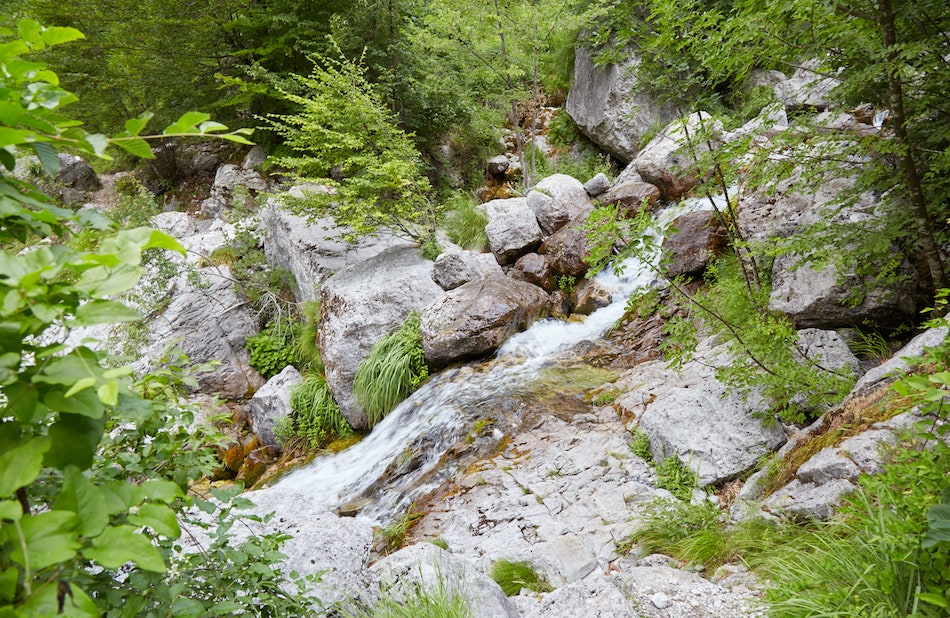
While stepping on the rocks is easy enough if you’re reasonably nimble, be sure to remember where you came from. Later, when returning from the waterfall, I couldn’t quite recall which section I’d initially crossed over, but I eventually figured it out after several minutes of exploration.
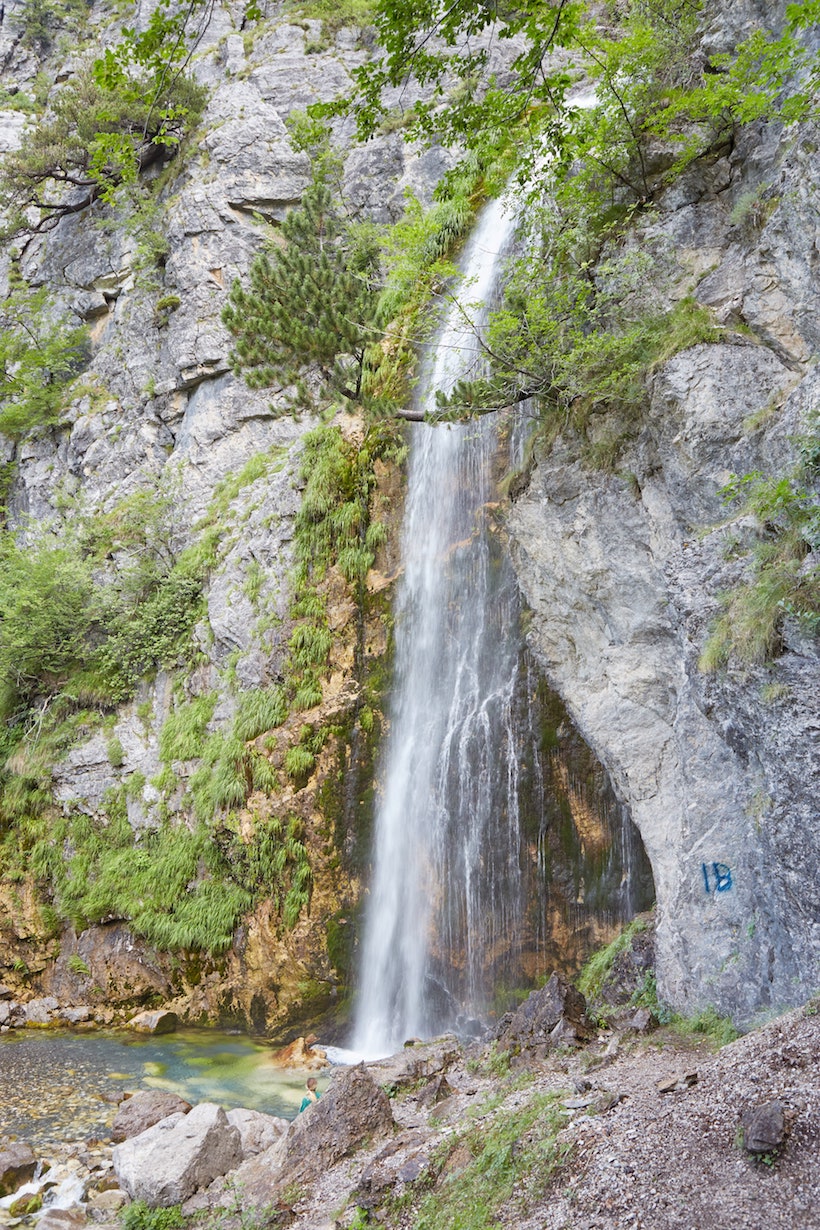

Once you make it over the large stream, the path up to the waterfall is pretty straightforward. After several minutes, you’ll come face to face with the 30 m-high waterfall, sourced from the snowcapped mountains high up above.
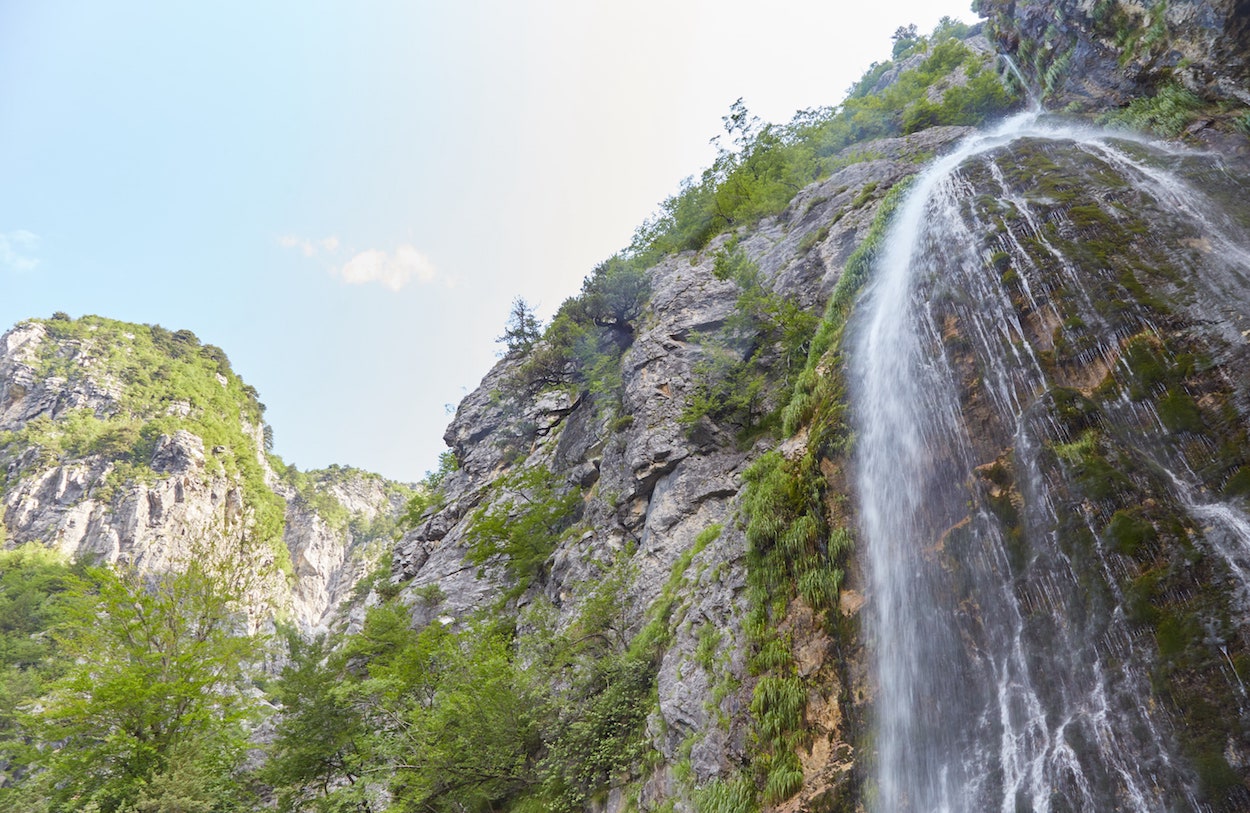
After admiring the strong yet gentle flow of the water, it’s time to make your way back down. The next hour or so is probably the most scenic portion of the hike (not counting the Blue Eye itself), providing excellent views of Albania’s Accursed Mountains.
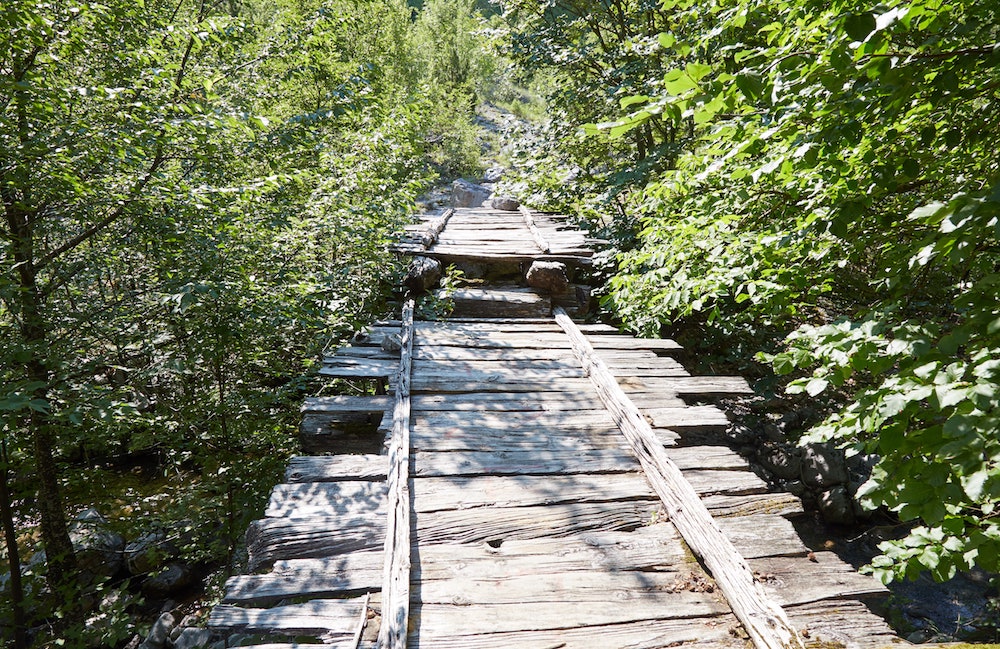
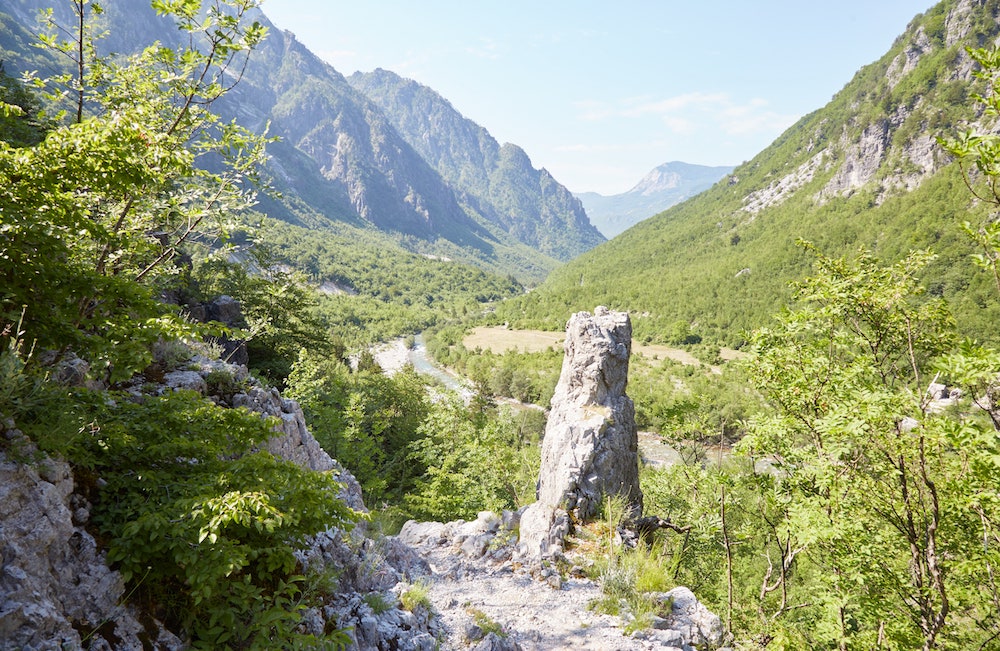
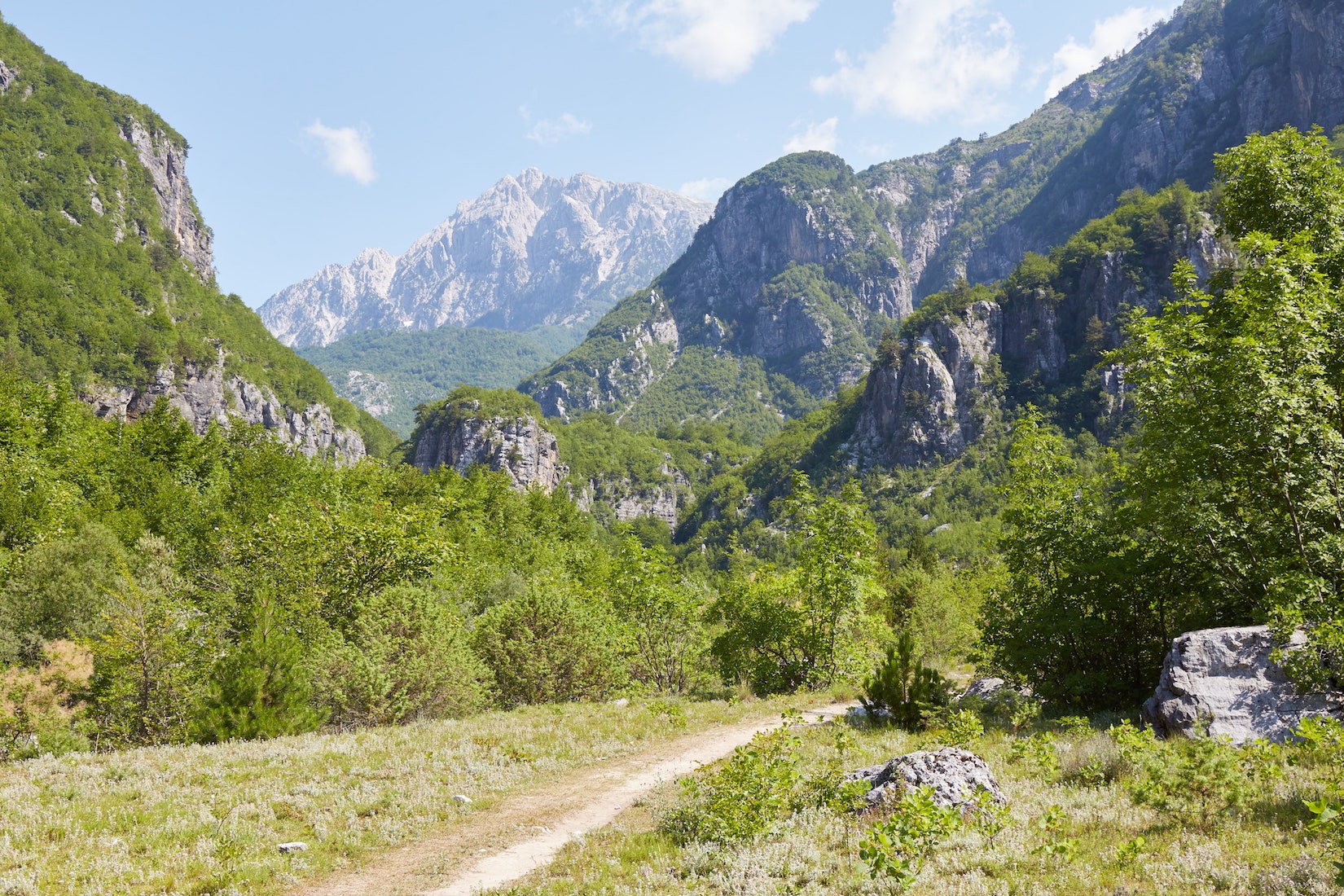

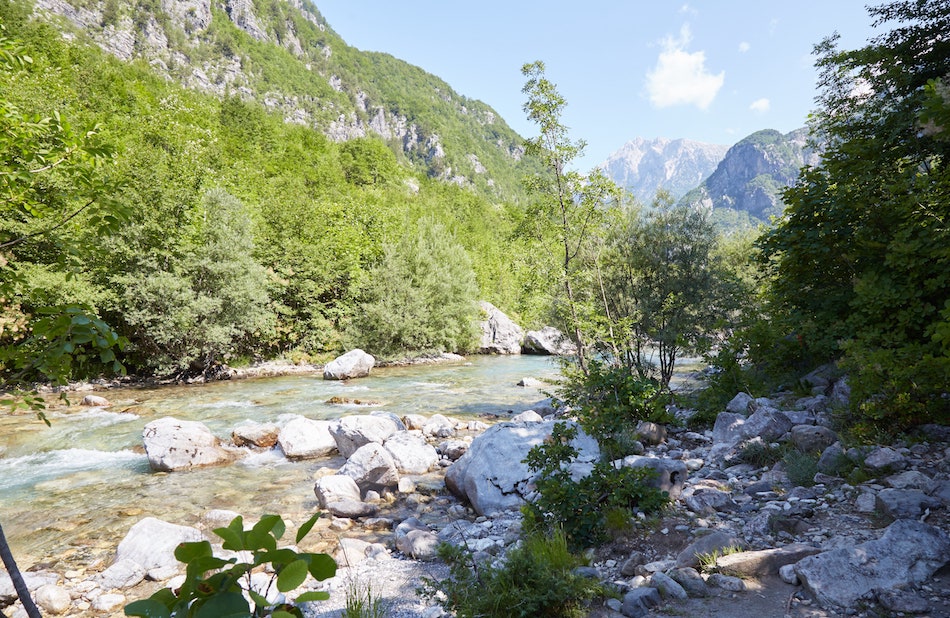
The path will occasionally take you alongside a small river, while you’ll even encounter a wooden viewing platform that extends directly over the water. While the view is nice, be very careful where you step!
The path from this point on is largely comprised of small white stones, and you’ll occasionally need to traverse large sections of dry riverbed. While not particularly dangerous, you’ll repeatedly need to climb over larger rocks. That’s why decent shoes come in handy here.
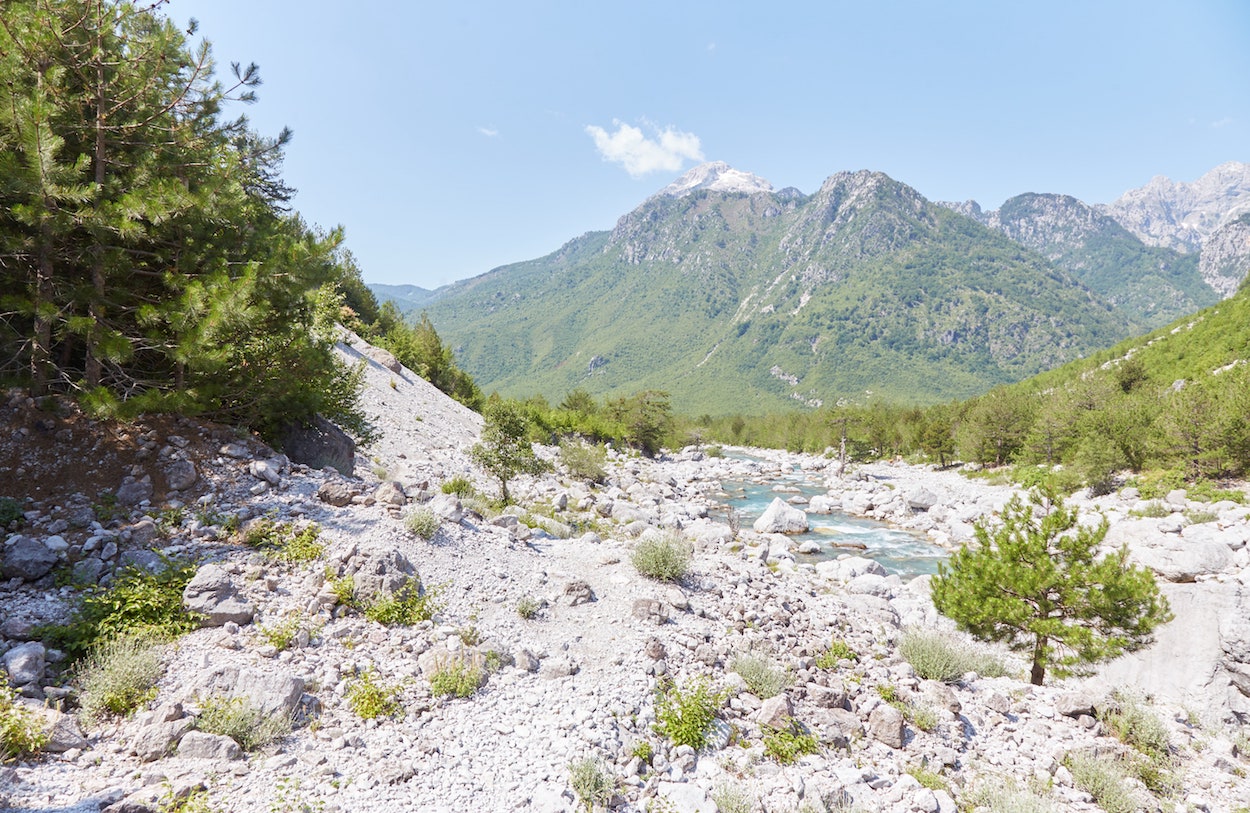
After a couple hours on the trail, you’ll finally see the very first sign mentioning the Blue Eye! (Syri I Kalter in Albanian.) But it points in a rather vague direction, so it’s imperative to closely follow Maps.me.
About an hour past the waterfall, you’ll reach one of the most confusing sections of the hike. After making a sharp right, take the next sharp left. Shortly after, the trail will fork into two, and you’ll want to take the lefthand path.
What makes this especially confusing is that given the stony terrain, it’s hard to make out which trail is which. But even if you get things wrong, you’re unlikely to waste more than several minutes.
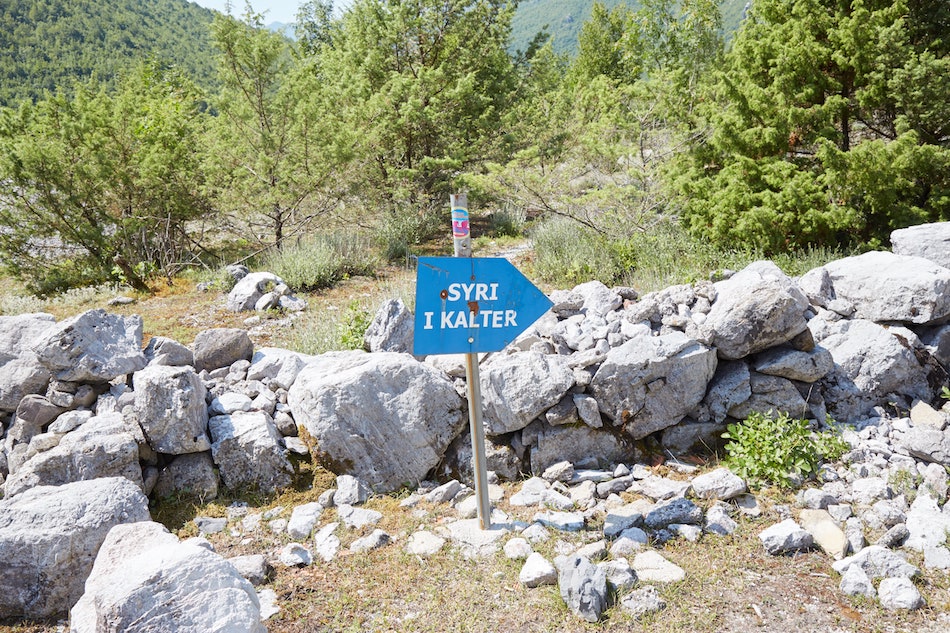
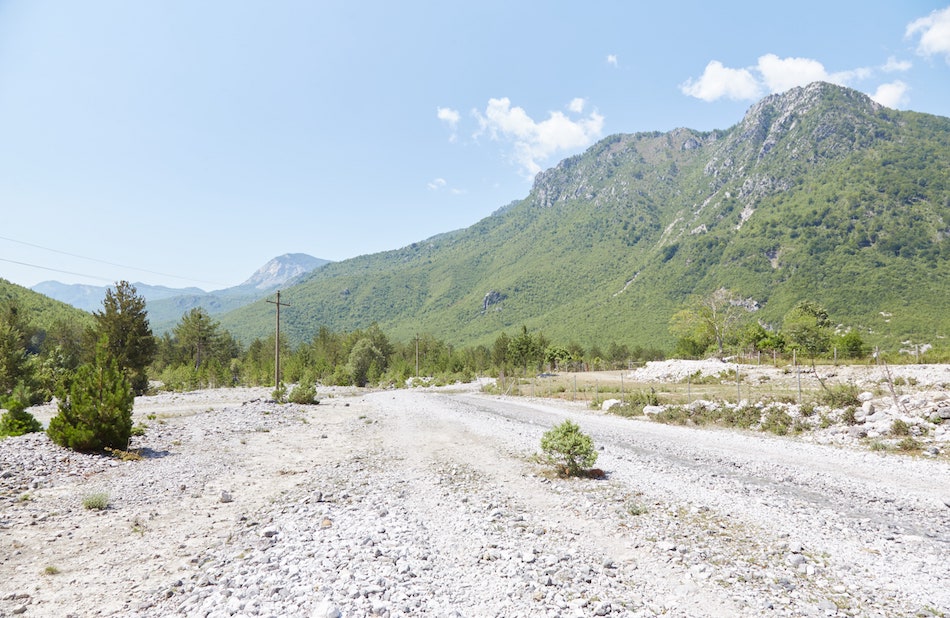

Continuing west, you’ll pass by a small farm on your righthand side. You’ll then encounter a large pond which you can walk across via a narrow wooden bridge.
If you’re feeling hungry, you’ll be relieved to find a cafe on the other side. There’s also a fountain at which you can freely fill up your water bottle.

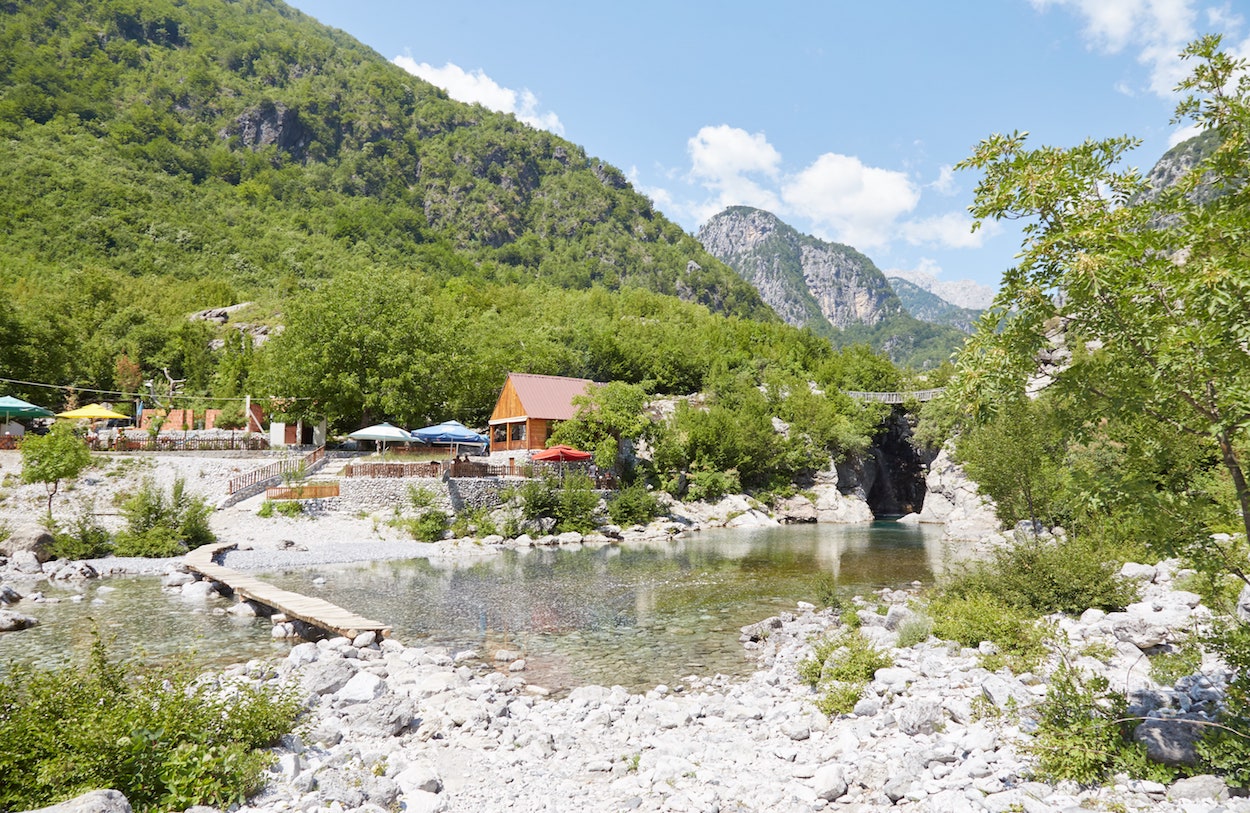
Past the cafe is yet another tricky part. You’ll want to walk up to another, higher bridge, that features a small Christian shrine to Mary on the other end. Past the bridge, you’ll encounter a few diverging pathways, not all of which appear on Maps.me.
One of them will have you walking up some rocky terrain, while another will have you walking along a small gorge filled with rushing water.
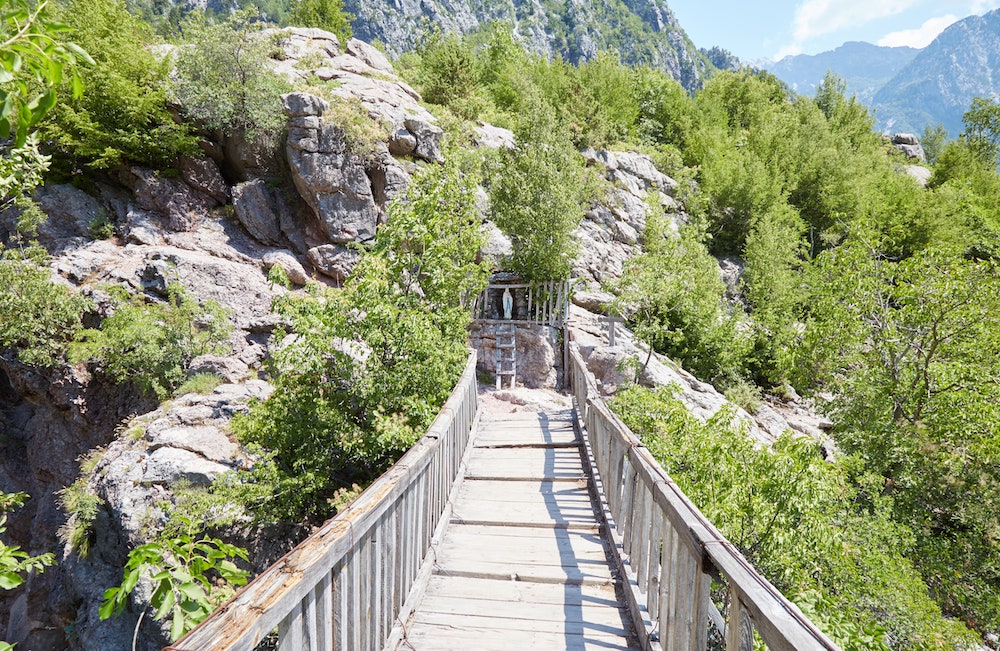

Generally speaking, you’ll want to head in the northwest direction, and more than one path can take you there. Eventually, you’ll encounter a very clearly defined trail through a valley that heads straight to the Blue Eye.
Don’t be surprised to suddenly see large crowds here, even if you’ve hardly encountered any other hikers up to this point on your trek!
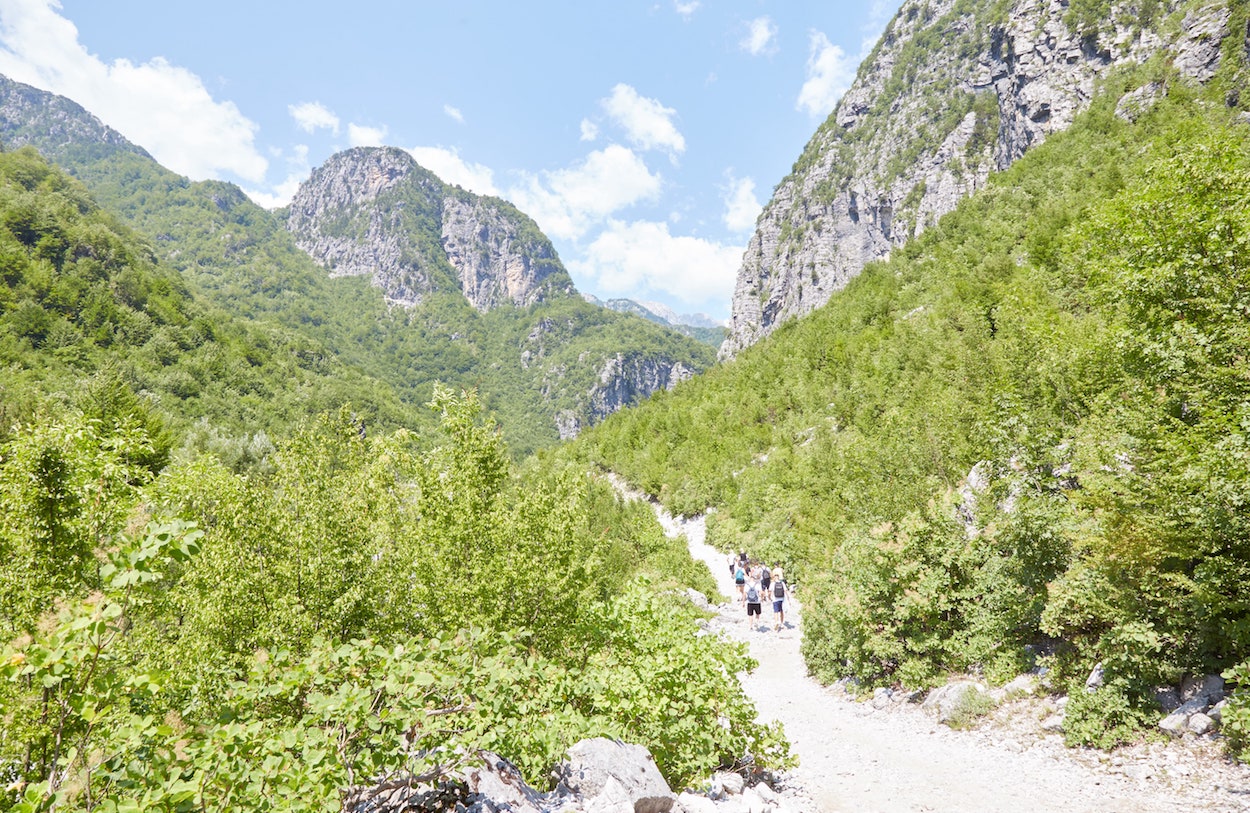
The Blue Eye is a very popular destination for locals. And with Theth having become more accessible than ever thanks to improved road networks, it’s becoming a common weekend excursion for families from the capital.
But few actually hike all the way from Theth. Most people drive and park their cars near the cafe. But from there, it’s still another hour or so to reach the Blue Eye. And this part also happens to be the most tiring section of the entire hike.
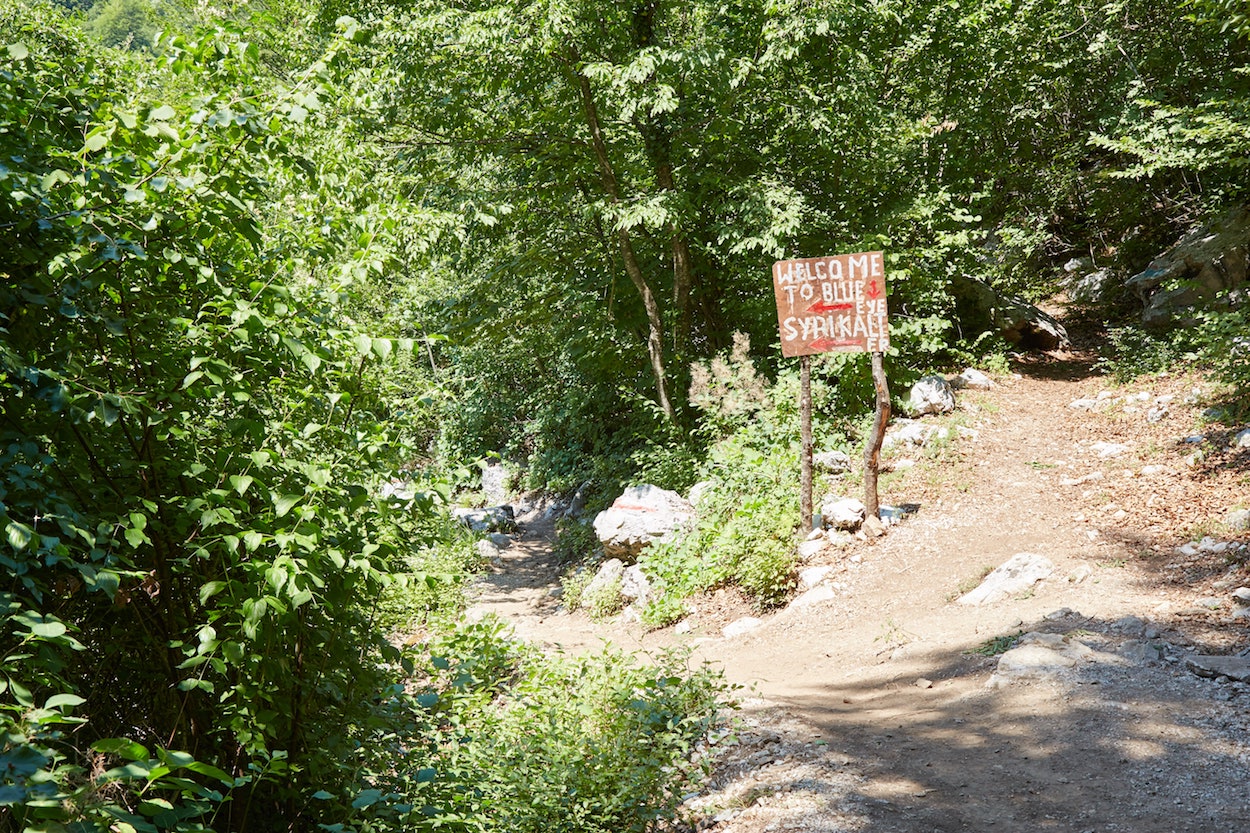
Given the flatness of the terrain up to this point, the slope of this last leg of the hike is sure to take you by surprise.
In my case, having just hiked from Valbonë to Theth the previous day, my stamina was a bit higher than normal. But given the heat and the constant uphill climb, I found myself breathing heavily.
Eventually, you’ll see a sign for the Blue Eye (only the second on this hike!), after which the journey is largely downhill. Passing over a bridge and past a local farm, you’ll finally encounter a staircase taking you right down to the main attraction.

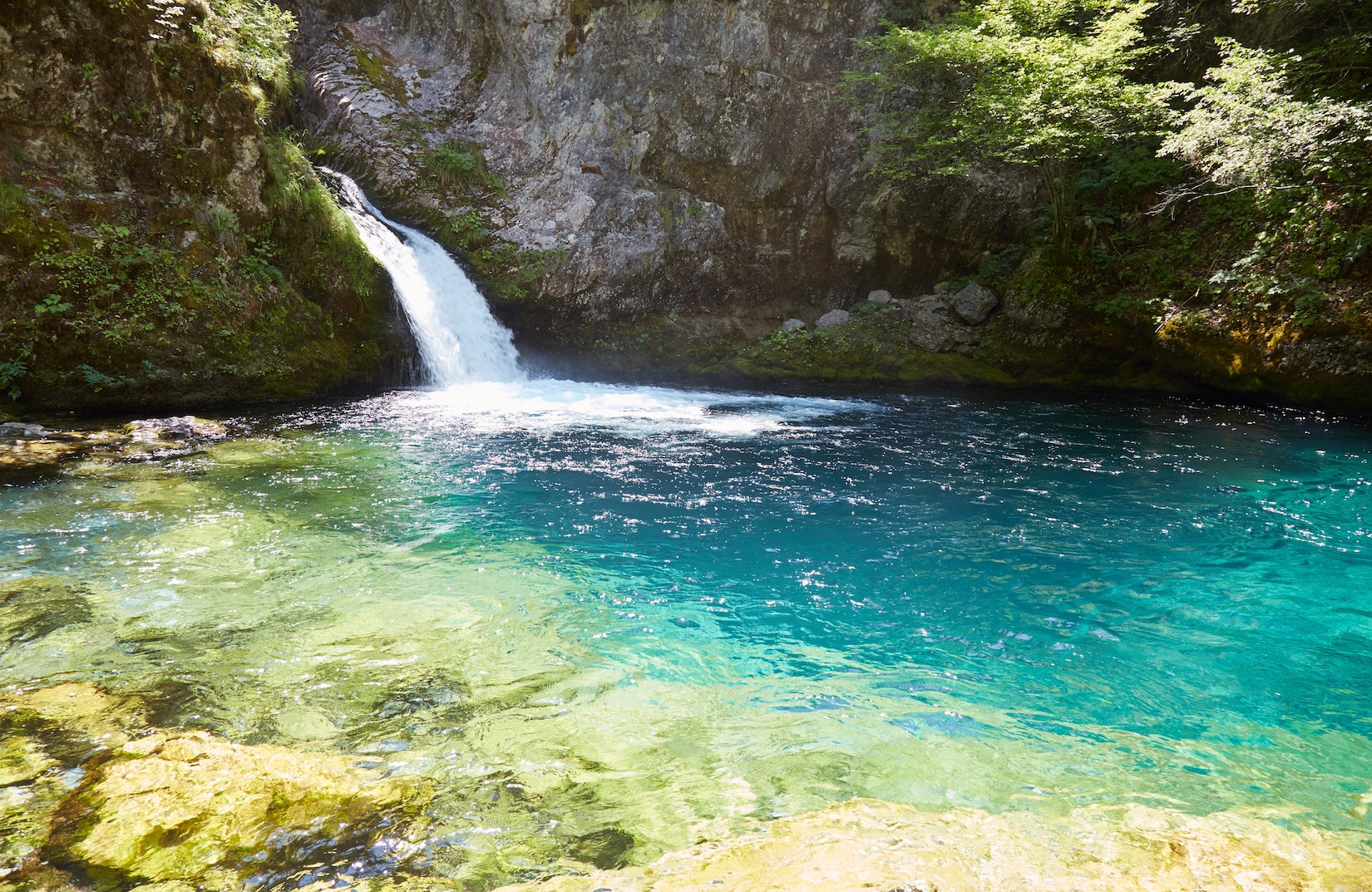
Once you see it in person, you’re unlikely to have any regrets about hiking to the Blue Eye. Sourced from the Black Drin River, the small waterfall flowing into the pool of turquoise water is a beautiful and soothing sight.
And in my opinion, this one’s much more impressive than the Blue Eye in Sarandë. It also lacks the kitschy souvenir shops of its sibling at the opposite end of the country.

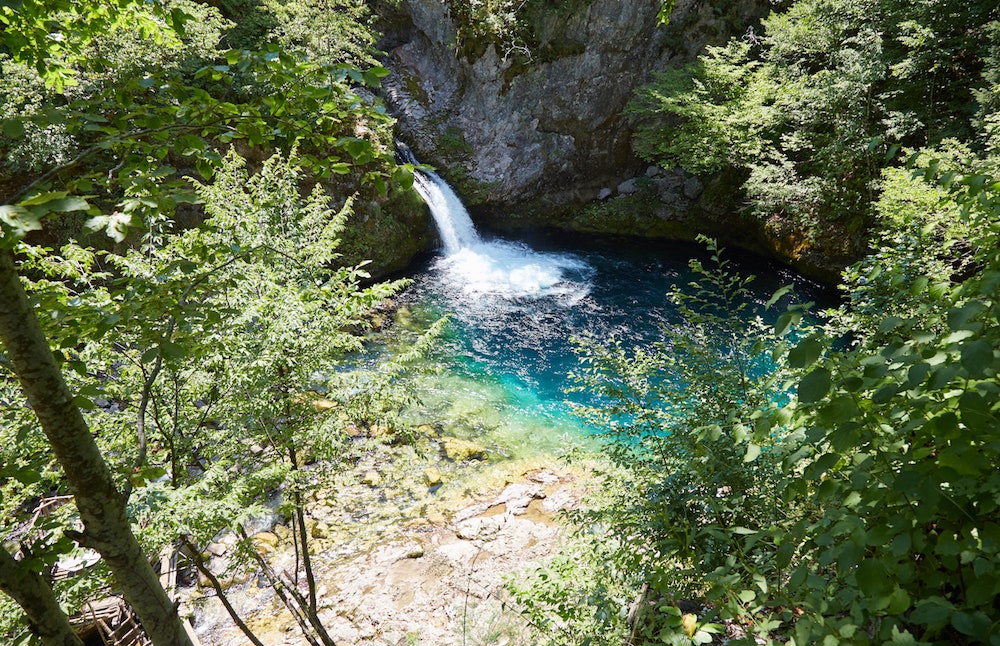
On the other side of the spring, you’ll find a staircase leading you to a cafe which overlooks the natural wonder. Even if you’re not ordering anything, the climb is worth it for the views.
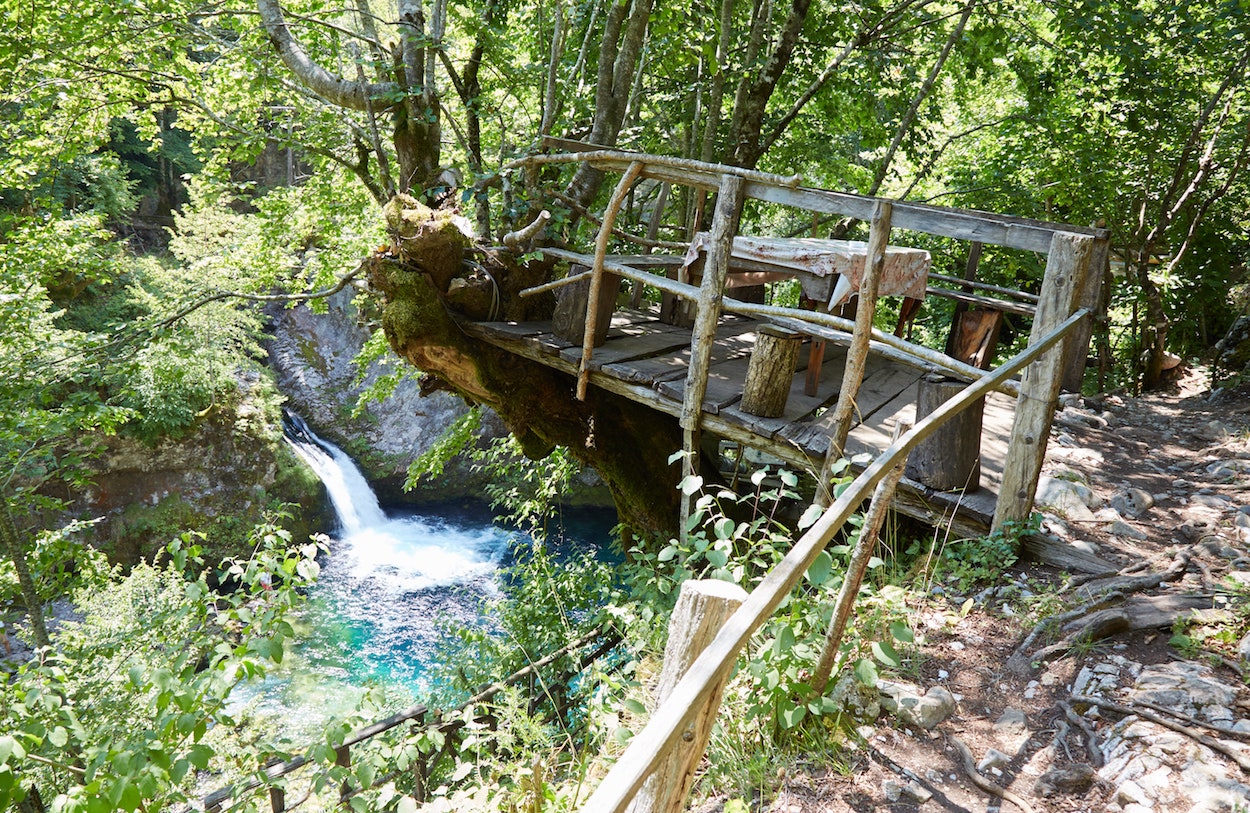

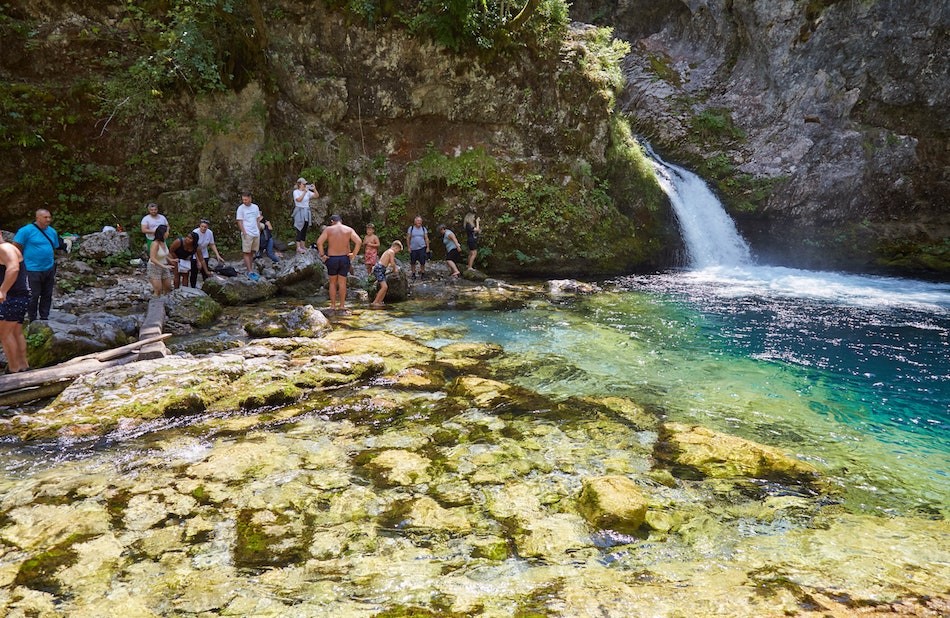
While I managed to speed ahead of the crowds during the last leg of the hike, people started arriving en masse before long. And many came prepared to swim. But at around 7 degrees Celsius, few can last even a minute in the water!
Despite the hot summer day, it was rather comical to see people hop in before screaming and immediately trying to come back out.
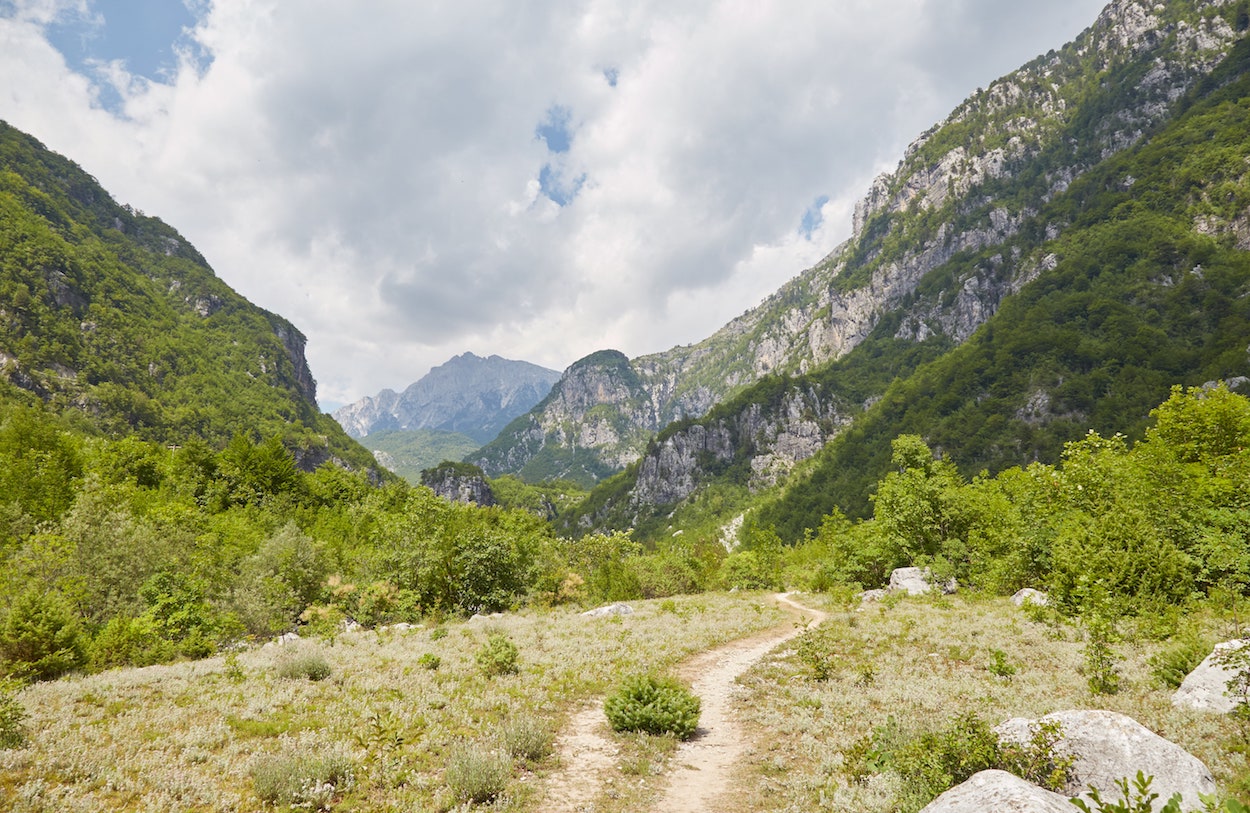
After lingering for a while and taking in the scenery, I began my long return trip to Theth. The main downside of hiking to the Blue Eye is that you have to return the exact same way you came (though you can skip the waterfall this time). And at three hours long, the journey can get rather tedious.
Nevertheless, it’s well worth doing during your time in Theth, making for the perfect ‘cool-down’ hike after the long journey from Valbonë. It’s also a great option for those solely looking for an easier hike.
Additional Info
In Theth, I deliberately chose to stay somewhere that would give me a head start for hiking to the Blue Eye. I went with Shpella Guest House which is located right near the Kulla tower and Theth Church. But despite its high review score, location, unfortunately, was the only thing I found positive about Shpella.
To save money, I stayed in a shared dorm room. But in pricey Theth, even a shared room cost me about 2000 lek per night. While I always avoid shared dorm rooms in cities, the hostel experience is usually fine in national parks.
At such places, from my experience, most people hike in the day and are dead tired by evening. As such, I’ve rarely had issues with noise in a national park. But Shpella was different.
The guest house has an attached restaurant located right next to the dorm room, and it’s supposed to close at 22:00 or 22:30 (still too late for such an environment, in my opinion). But management is very flexible with their guests as long as they keep spending money at their overpriced restaurant (which serves mediocre food, I might add).
I really got the impression that they couldn’t care less about the other guests who simply came to hike and not blow loads of cash on drinks. As such, hikers staying at Shpella have put up with loud music past 1 am and the hollering and shouting from drunk guests partying right outside the rooms.
To make matters worse, the owners had a terrible attitude and never apologized or took any sort of responsibility. I’d have to say that not only was Shpella my worst accommodation experience in Albania, but probably in all of the Balkans!
It turns out that hikers actually make up a small percentage of all those staying in Theth. Loads of Tirana residents and international tourists flock to the village in the summer and use guesthouses like Shpella as their personal party spaces (and I imagine these are the people behind most of Shpella’s positive reviews).
Now that you know where NOT to stay, where should one stay in Theth? If you’re planning on doing the Blue Eye hike, I’d look for somewhere relatively near Shpella.
The high-rated Bujtina Polia seems like a good option. While it does have an attached restaurant/bar, there don’t seem to be any mentions in the reviews about noise and sleep issues. Guesthouse Marashi is another high-rated place nearby, though numerous guests have complained about noise in the reviews.
If you’re hiking from Valbonë to Theth and want to put your bags down as soon as you reach the village, look for somewhere near the trailhead. The village’s only market happens to be around here as well. Guest House Flodisa seems like a good option in this area.
If you’re short on time, don’t feel like figuring out all the logistics yourself, or simply feel more comfortable getting around with a guide, you also have the option of taking a tour around Theth and to the Blue Eye.
This high-rated 2-day private tour, which departs from Tirana, will take you to the Blue Eye, Grunas Waterfall, the Kulla (Lock-In Tower) and numerous scenic vantage points around the area.

Pin It!
